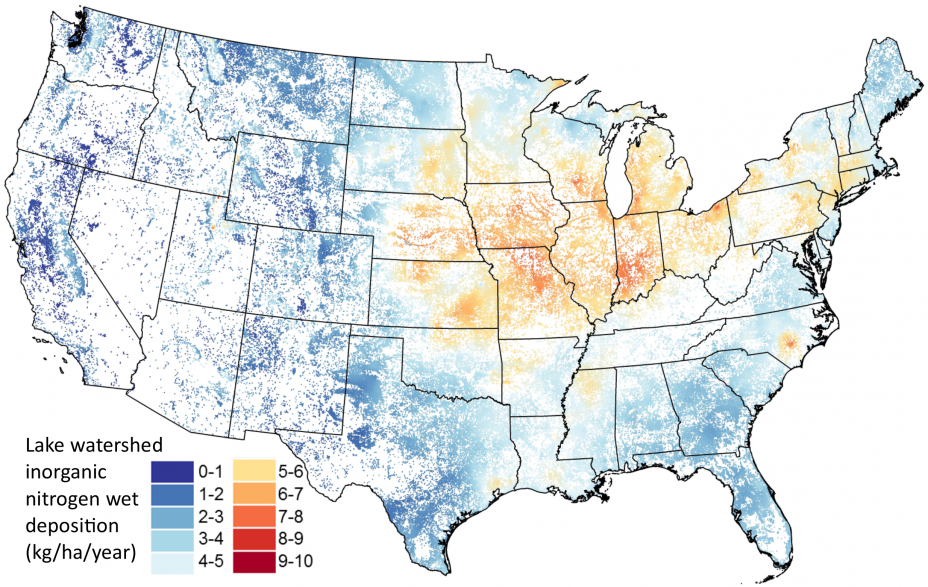LakeCat Dataset
LakeCat currently contains over 300 metrics that include local catchment (Cat), watershed (Ws), and special metrics. See Geospatial Framework and Terms in the ReadMe for definitions of the terms ‘catchment’ and ‘watershed’ as used with the LakeCat Dataset. An additional metric, inStreamCat, indicates whether the variable was pulled from the StreamCat Dataset or calculated with a geospatial framework that was developed for LakeCat.
These metrics are available for 378,088 lakes and their associated catchments across the conterminous US. LakeCat metrics represent both natural (e.g., soils and geology) and anthropogenic (e.g, urban areas and agriculture) landscape information.
 Example of a U.S. map created with LakeCat data of mean watershed inorganic nitrogen wet deposition (kg/ha/year)
Example of a U.S. map created with LakeCat data of mean watershed inorganic nitrogen wet deposition (kg/ha/year)
Updates & Corrections (Latest update - November 5, 2018)
Be sure to check here for recent updates and corrections to the LakeCat Dataset.
Access LakeCat Data
- Data by landscape layer
- LakeCat Geospatial Framework - GIS layers and tables used to process off-network lakes
LakeCat Documentation
- A detailed description of the LakeCat Dataset and its development is now available in the journal Freshwater Science.
- Please include the following citation in any publication or presentation including LakeCat data: Hill, Ryan A., Marc H. Weber, Rick Debbout, Scott G. Leibowitz, Anthony R. Olsen. 2018. The Lake-Catchment (LakeCat) Dataset: characterizing landscape features for lake basins within the conterminous USA. Freshwater Science doi:10.1086/697966.
- The Read Me file provides additional detail and important information on how to access and use the LakeCat Dataset.
- The Variable List provides a quick reference of available watershed metrics.
- The Data Dictionary provides a comprehensive description of each watershed metric and how they were derived.
- Metadata
- Documentation is provided on the steps that were followed to develop and conduct quality assurance on the LakeCat Dataset.
- The LakeCat GitHub page has the latest working versions of LakeCat code and a brief description of each script we used to develop the LakeCat Dataset, including examples of tables used to control the processing of LakeCat.
Disclaimer
Although these data have been processed successfully on a computer system at the United States Environmental Protection Agency (EPA), no warranty expressed or implied is made regarding the accuracy or utility of the data on any other system or for general or scientific purposes, nor shall the act of distribution constitute any such warranty. It is also strongly recommended that careful attention be paid to the contents of the metadata file associated with these data to evaluate data set limitations, restrictions, or intended use. The EPA shall not be held liable for improper or incorrect use of the data described and/or contained herein.
